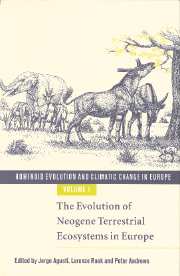Book contents
- Frontmatter
- Contents
- List of contributors
- Acknowledgements: The European Science Foundation
- 1 Introduction
- PART I Palaeogeography of the circum-Mediterranean region
- PART II Miocene mammalian successions
- PART III Palaeoenvironments: non-mammalian evidence
- PART IV Palaeoenvironments: mammalian evidence
- 19 Shrews (Mammalia, Insectivora, Soricidae) as paleoclimatic indicators in the European Neogene
- 20 Mammal turnover and global climate change in the late Miocene terrestrial record of the Vallès-Penedès Basin (NE Spain)
- 21 Palaeoenvironments of late Miocene primate localities in Macedonia, Greece
- 22 The paleoecology of the Pikermian Biome and the savanna myth
- 23 Vicariance biogeography and paleoecology of Eurasian Miocene hominoid primates
- Index
23 - Vicariance biogeography and paleoecology of Eurasian Miocene hominoid primates
from PART IV - Palaeoenvironments: mammalian evidence
Published online by Cambridge University Press: 15 December 2009
- Frontmatter
- Contents
- List of contributors
- Acknowledgements: The European Science Foundation
- 1 Introduction
- PART I Palaeogeography of the circum-Mediterranean region
- PART II Miocene mammalian successions
- PART III Palaeoenvironments: non-mammalian evidence
- PART IV Palaeoenvironments: mammalian evidence
- 19 Shrews (Mammalia, Insectivora, Soricidae) as paleoclimatic indicators in the European Neogene
- 20 Mammal turnover and global climate change in the late Miocene terrestrial record of the Vallès-Penedès Basin (NE Spain)
- 21 Palaeoenvironments of late Miocene primate localities in Macedonia, Greece
- 22 The paleoecology of the Pikermian Biome and the savanna myth
- 23 Vicariance biogeography and paleoecology of Eurasian Miocene hominoid primates
- Index
Summary
Introduction
A characteristic of Eurasian Miocene hominid primates is their patchy distribution, both in time and space. It is exceptional to have a concentration of more than 140 specimens from a single locality, such as occurs at Rudabánya (Begun & Kordos, 1997). However, Rudabánya, like most Eurasian localities, represents a restricted stratigraphic interval. We never have well developed stratigraphic sequences of abundantly represented evolving hominid lineages comparable to rodent assemblages, or large samples of a taxon occurring among dozens of localities as for instance with late Miocene hipparionine horses. The only Eurasian hominid stratigraphic sequences of any length are those from Spain (c. 12–9.5 Ma; Garcés et al., 1996), Italy (Rook et al., this volume) and the extraordinary record from the Siwaliks (12.5–7 Ma; Kappelman et al., 1996).
Despite this patchy concentration, there is a relatively great diversity of generic-level lineages of higher primates which exhibit an interesting, albeit confusing, array of primitive characters (McCrossin & Benefit, 1997) and clear homoplasies in both the cranial and postcranial complexes (Begun & Kordos, 1997). Moreover, the fossil record is vastly improved compared to 30 years ago (Pilbeam, 1996), and this record allows meaningful comparison of a variety of hominid phylogenetic hypotheses. In recent years there have been a number of new competing hypotheses published which implicitly propose phylogenetic relationships between fossil and extant species. These phylogenetic reconstructions have been based on morphological evidence without regard to geographical or ecological factors that regulate species dispersion and evolution, and it is our intention here to investigate these latter aspects of Eurasian Miocene hominoid evolution.
- Type
- Chapter
- Information
- Hominoid Evolution and Climatic Change in Europe , pp. 454 - 487Publisher: Cambridge University PressPrint publication year: 1999
- 17
- Cited by



